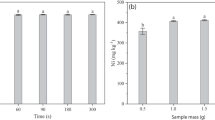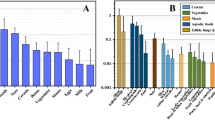Abstract
Gamma-ray spectrometry was performed on 26 tea leaf products from seven countries to determine the difference in radiation exposure doses based on the place of origin. The difference in radioactivity concentrations exceeded ten-fold for both naturally occurring radionuclides and 137Cs. Assuming an annual tea leaf consumption of 1 kg/capita, the maximum difference in the radiation dose was estimated to be 3.1 and 0.25 µSv/y for uranium or thorium series nuclides and 137Cs, respectively. Considering the contributions of 210Pb and 210Po, which were not measured in this study, the difference will be much larger. However, this dose is much lower than the worldwide radiation exposure from natural sources, which is expected to be in a range of 1–10 mSv, with an average of 2.4 mSv.




* statistically significant transfer (p ≤ 5%), 226Ra = weighted mean of 214Pb and 214Bi, 228Ra = 228Ac, 228Th = weighted mean of 212Pb, 212Bi, and 208Tl


Similar content being viewed by others
References
United Nations Scientific Committee on the Effects of Atomic Radiation (2010) UNSCEAR 2008 Report, Annex B. Exposures of the public and workers from various sources of radiation, United Nations, New York
Ota T, Sanada T, Kashiwara Y, Morimoto T, Sato K (2009) Evaluation for committed effective dose due to dietary foods by the intake for Japanese adults. Jpn J Health Phys 44:80–88
Food and Agriculture Organization, United Nations. https://www.fao.org/faostat/en/#home. Accessed 5 Aug 2022
International Atomic Energy Agency (2010) IAEA Technical Report 472, Handbook of parameter values for the prediction of radionuclide transfer in terrestrial and freshwater environments. IAEA, Vienna
International Commission on Radiological Protection (2012) Compendium of dose coefficients based on ICRP Publication 60 (ICRP Publication 119). Elsevier, Amsterdam
United Nations Scientific Committee on the Effects of Atomic Radiation (2000) UNSCEAR 2000 Report, Annex B. Exposure from natural radiation sources. United Nations, New York
Levine CP, Mattson NS (2021) Potassium-deficient nutrient solution affects the yield, morphology, and tissue mineral elements for hydroponic baby leaf spinach (Spinacia oleracea L). Horticulturae 7:213
Mondal MF, Asaduzzaman M, Ueno M, Kawaguchi M, Yano S, Ban T, Tanaka H, Asao T (2017) Reduction of potassium (K) content in strawberry fruits through KNO3 management of hydroponics. Horticulture J 86:26–36
Igarashi Y, Aoyama M, Hirose K, Miyao T, Nemoto K, Tomita M, Fujikawa T (2003) Resuspension: decadal monitoring time series of the anthropogenic radioactivity deposition in Japan. J Radiat Res 44:319–328
Gökmen IG, Birgül O, Kence A, Gökmen A (1995) Chernobyl radioactivity in Turkish tea and its possible health consequences. J Radioanal Nucl Chem 198:487–497
United Nations Scientific Committee on the Effects of Atomic Radiation (2014) UNSCEAR 2013 Report, Annex A. Levels and effects of radiation exposure due to the nuclear accident after the 2011 great east-Japan earthquake and tsunami. United Nations, New York
Ministry of Agriculture, Forestry and Fisheries, Japan. https://www.maff.go.jp/j/kanbo/joho/saigai/s_chosa/H24gaiyou.html#cha. Accessed 5 Aug 2022
Al-Masri MS, Nashawati A, Amin Y, Al-Akel B (2004) Determination of 210Po in tea, maté and their infusions and its natural intake by Sirians. J Radioanal Nucl Chem 260:27–34
Desideri D, Meli MA, Roselli C, Feduzi L (2011) Alpha and gamma spectrometry for determination of natural and artificial radionuclides in tea, herbal tea and camomile marketed in Italy. Microchem J 98:170–175
Puchkova EV, Bogdanova OG (2016) 210Po in black and green teas. Radiochemistry 58:98–105
Ministry of Agriculture, Forestry and Fisheries, Japan. https://www.maff.go.jp/j/syouan/seisaku/kakou/greentea_pb.html. Accessed 5 Aug 2022
Brzezicha-Cirocka J, Grembecka M, Szefer P (2016) Monitoring of essential and heavy metals in green tea from different geographical origins. Environ Monit Assess 188:183
Yao Q, Huang M, Zheng Y, Chen M, Huang C, Lin Q (2022) Prediction and health risk assessment of copper, lead, cadmium, chromium, and nickel in Tieguanyin tea: a case study from Fujian, China. Food 11:1593
Tagami K, Uchida S, Ishii N (2012) Extractability of radiocesium from processed green tea leaves with hot water: the first emergent tea leaves harvested after the TEPCO’s Fukushima Daiichi Nuclear Power Plant accident. J Radioanal Nucl Chem 292:243–247
Zehringer M, Kammerer F, Wagmann M (2018) Radionuclides in tea and their behaviour in the brewing process. J Environ Radioact 192:75–80
Cook MC, Stukel MJ, Zhang W, Mercier JF, Cooke MW (2016) The determination of Fukushima-derived cesium-134 and cesium-137 in Japanese green tea samples and their distribution subsequent to simulated beverage preparation. J Environ Radioact 153:23–30
Sato I, Sasaki J, Satoh H, Okada K (2019) Effects of treatment time and thickness of meat on the removal of radioactive cesium from beef slices by boiling and water extraction. J Food Protect 82:623–627
Tagami K, Uchida S (2013) Comparison of food processing retention factors of 137Cs and 40K in vegetables. J Radioanal Nucl Chem 295:1627–1634
Harb S (2007) Measurement of the radioactivity of 238U, 226Ra, 210Pb, 228Th, 232Th, 228Ra, 137Cs and 40K in tea using gamma-spectrometry. J Radioanal Nucl Chem 274:63–66
Author information
Authors and Affiliations
Corresponding author
Ethics declarations
Conflict of interest
The author have no competing interests to declare that are relevant to the content of this article.
Additional information
Publisher's Note
Springer Nature remains neutral with regard to jurisdictional claims in published maps and institutional affiliations.
Rights and permissions
Springer Nature or its licensor (e.g. a society or other partner) holds exclusive rights to this article under a publishing agreement with the author(s) or other rightsholder(s); author self-archiving of the accepted manuscript version of this article is solely governed by the terms of such publishing agreement and applicable law.
About this article
Cite this article
Sato, I. Regional differences in the levels of naturally occurring radionuclides and 137Cs in commercial tea leaf products. J Radioanal Nucl Chem 332, 2115–2122 (2023). https://doi.org/10.1007/s10967-023-08817-4
Received:
Accepted:
Published:
Issue Date:
DOI: https://doi.org/10.1007/s10967-023-08817-4




